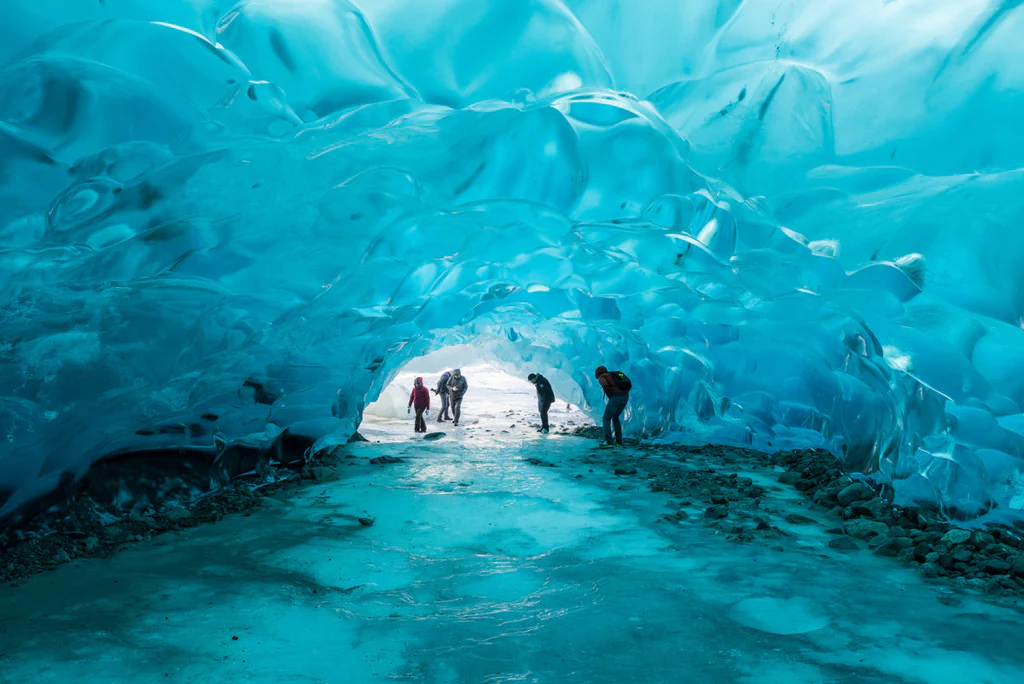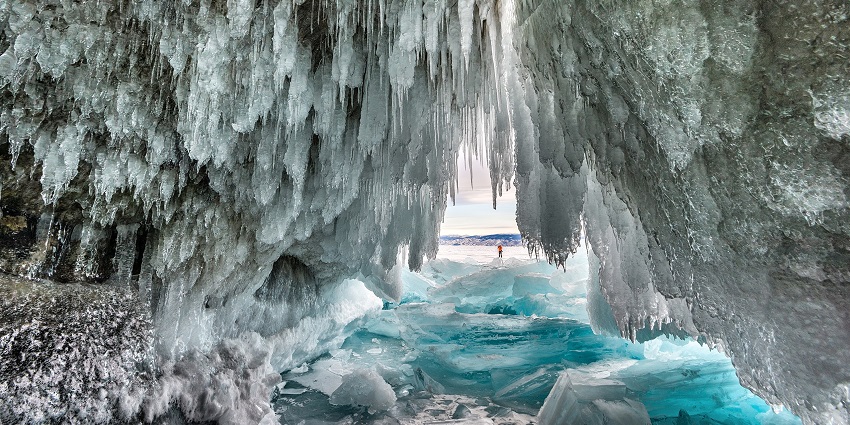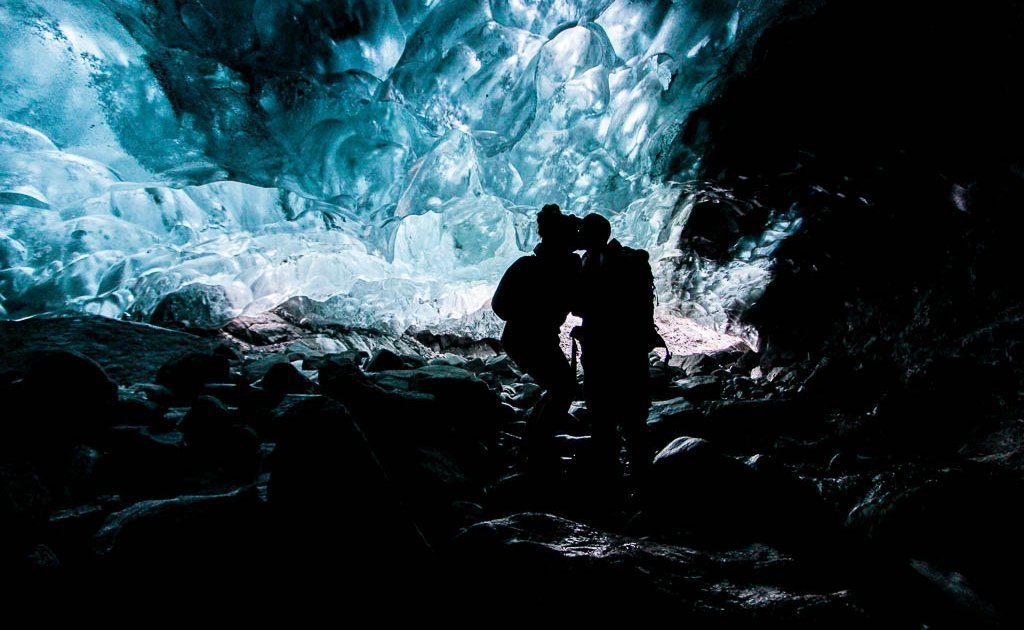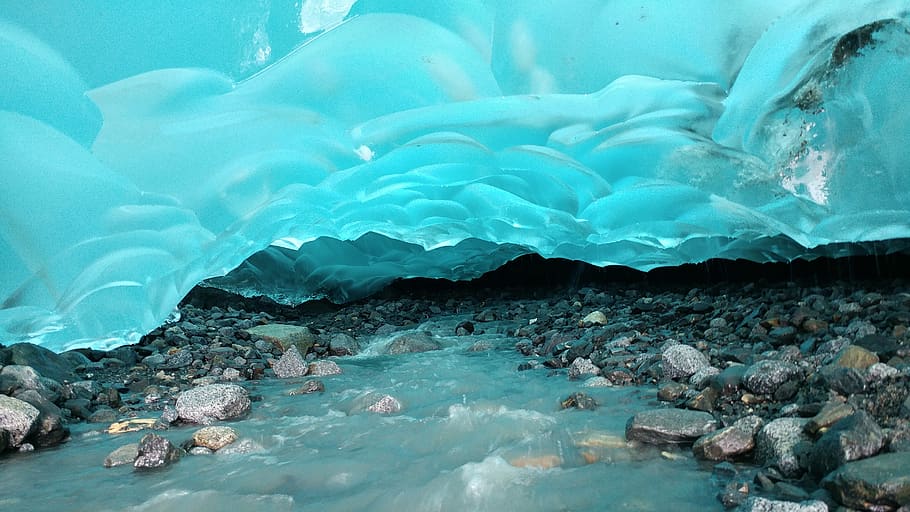Imagine stepping into a glowing blue tunnel where every inch of the wall looks like it was painted by Elsa from Frozen after she discovered Pinterest. Welcome to the Mendenhall Ice Caves in Juneau, Alaska — a place so stunning, it makes your smartphone camera feel underqualified.
Nope, this isn’t CGI. And no, you don’t need a Hollywood green screen or a dozen Instagram filters. The glowing blue light, the crystal-clear frozen ceilings, and the sheer what-the-heck-is-this-place vibe are all 100% real. It’s basically what happens when Mother Nature decides to flex on us.
But before you go strapping on snowshoes and yelling “Adventure Time!”, let’s slow down and get into the icy (pun intended) details. How do you even get to these magical caves? Can anyone go? Is it dangerous? What should you pack? And will your friends believe you when you say you walked inside a glacier?
Let’s dive in — carefully, because the floor might be slippery.
What Are the Mendenhall Ice Caves?

The Mendenhall Ice Caves are a part of the Mendenhall Glacier, which stretches for about 13 miles (21 kilometers) and lies just outside of Juneau, Alaska. While the glacier itself is a massive chunk of ancient ice that’s been slowly crawling through the valley for thousands of years, the real showstoppers are the ice caves hidden inside it.
These caves form when meltwater carves tunnels through the glacier during warmer months. The result? Glowing hallways of translucent blue ice that look straight out of a fantasy movie. It’s like Narnia, if Narnia had a humidity problem and made your nose hairs freeze.
But here’s the kicker: these caves aren’t permanent. They’re constantly changing, shifting, and sometimes collapsing. So every visit is unique — one year’s epic tunnel might be gone the next. It’s nature’s limited-time-only pop-up exhibit.
Where Is This Place, and How Do You Get There?

Alright, so where is this frozen slice of heaven, and how do you reach it without dying of frostbite or getting lost like a confused penguin?
The glacier is about 12 miles from downtown Juneau, and the closest you can drive is to the Mendenhall Glacier Visitor Center. From there, you’re not exactly taking a scenic stroll with hot cocoa in hand. The trek to the caves is off-trail, rugged, and, depending on the season, can include ice hiking, rock scrambling, and crossing slippery terrain.
The Main Routes:
-
West Glacier Trail – This is the most common route. It’s about a 6 to 8-mile round-trip hike (that’s 10–13 km if you’re metric-minded). You’ll hike through the forest, over rocks, and eventually reach the glacier’s edge.
-
Helicopter Tours – Feeling fancy (and a bit lazy)? Several local companies offer helicopter tours that drop you closer to the glacier — a bougie but breathtaking option.
⚠️ Warning: There’s no officially marked trail into the caves, and conditions change constantly. Many recommend hiring a local guide, especially if it’s your first time or you’re not an experienced hiker. Ice is slippery, who knew?
When’s the Best Time to Visit the Mendenhall Ice Caves?
So, when should you pack your thermal socks and prepare to live your best icy life?
Late Summer to Early Fall (July – September)

This is generally the golden window. During this period:
-
The ice caves are often more accessible because of glacial meltwater creating those magical tunnels.
-
The trails are less snowy, so you won’t need to cosplay as an Arctic explorer (unless you want to).
-
The weather is… well, less harsh. “Warm” in Alaska still means “bring a jacket, ya goof.”
Winter and Spring (October – June)
-
Snow covers the trails. A lot of it.
-
The caves may be inaccessible or dangerously unstable.
-
And unless you’re into skiing your way across bear country in a blizzard, you might want to wait it out.
TL;DR:
-
Best time? July–September.
-
Best weather? “Alaska nice,” aka still cold, but your eyelashes won’t freeze shut.
-
Best light? Mornings or late afternoons when the sun hits the glacier just right and the cave glows like a blue lava lamp.
What Should You Bring? (And What to Leave at Home Unless You Wanna Regret Life)
This ain’t your average hike. You’re dealing with ice, uneven terrain, and possibly yeti-level cold. Here’s a checklist to make sure you don’t end up using your sock as a glove.
Must-Haves:
-
Waterproof hiking boots – Ice + rocks + water = ankle’s worst nightmare.
-
Warm, layered clothing – Dress like an onion. You can always peel off layers. You can’t add what you didn’t bring.
-
Gloves & hat – Because your fingers and ears enjoy functioning.
-
Crampons or microspikes – They sound like dinosaur names, but they keep you from falling on your butt.
-
Trekking poles – Optional, but very handy on slippery rocks.
-
Snacks & water – Hangry + cold = tragic.
-
Headlamp or flashlight – It’s dark inside a glacier. Who knew?
-
Dry bag – In case your phone wants to go swimming.
-
Guide or GPS app – Because this trail is not marked, and Mother Nature didn’t leave breadcrumbs.
What to Leave at Home:
-
Flip flops – Please. Don’t.
-
Drones – Not always allowed, and that buzzing ruins the magic.
-
Bluetooth speakers – No one came here to listen to your playlist. Let the ice cave speak.
Is It Safe? Let’s Talk Danger (and Not Just the Cool Kind)

Okay, here’s the real talk: The Mendenhall Ice Caves are mind-blowingly beautiful, but they’re also a little… unstable. Like your ex. Or a Jenga tower in an earthquake.
Potential Risks:
-
Collapsing Ice – The caves change shape constantly, and they can cave in. Literally.
-
Falling Rocks & Ice Chunks – Not the kind you want to keep as souvenirs.
-
Slippery Surfaces – One wrong step and suddenly you’re glissading on your backside.
-
Getting Lost – Trails aren’t marked, GPS signals get weird, and the landscape can be deceiving.
-
Weather Shifts – In Alaska, the sky can go from sunny to stormy faster than you can say “hypothermia.”
Safety Tips:
-
Always check weather conditions before your trip.
-
Go with a local guide if you’re not super experienced.
-
Let someone know your plan and estimated return time.
-
Don’t go inside the caves if there’s been recent heavy rain or melting.
Why Is the Ice So Blue? (Science Alert!)
No, the ice caves didn’t get tinted by Instagram influencers. That shimmering blue glow is real, and it happens thanks to a fun little science trick:
Glacial ice is super dense. Over centuries, the weight of accumulated snow compresses the air bubbles out of the ice. When sunlight enters, the ice absorbs the red and yellow parts of the light spectrum and scatters the blue, making the cave walls glow like some kind of enchanted frozen sapphire.
It’s science cosplay as magic.
Final Thoughts: Worth the Hype? Frozen-Lutely.
So, are the Mendenhall Ice Caves worth the trek, the gear, the frozen toes, and the mild existential crisis when you realize a ceiling of ancient ice is hovering above your head?
Absolutely. It’s not just a destination — it’s an experience straight out of a fantasy novel. One where the plot twist is: you’re actually in it.
Sure, it’s not the easiest adventure. You’re not walking into Disneyland with a churro in one hand. You’re trekking through forests, possibly crawling over icy boulders, and whispering prayers to your crampons. But the payoff? Stepping into a glowing, blue-lit wonderland that makes even the most skeptical traveler go, “Wait, this is real?!”
If you’re lucky enough to visit while the caves are accessible and safe, go. Take the hike. Bring a guide. Snap the photos. But more importantly, just be there. Soak it in. Touch the ancient ice (gently). Listen to the silence. Feel how small and awesome the world can be.
Because while filters and fantasy are fun, sometimes the most magical places are the ones nature built — slowly, silently, and beautifully — over thousands of years.
Estimated Costs for Visiting the Mendenhall Ice Caves
Here’s a breakdown of what you might spend if you’re planning your icy adventure. Prices are in USD and may vary depending on the season, availability, and how fancy you like your snacks.
| Item | Estimated Cost | Notes |
|---|---|---|
| Flight to Juneau, Alaska | $300 – $800 (round trip) | From major U.S. cities, international calls may cost more |
| Local transportation (taxi, shuttle, or rental) | $20 – $100 | Depending on how far you’re staying from the Visitor Center |
| Guided hiking tour | $100 – $250 | Strongly recommended for safety and access |
| Helicopter glacier tour | $300 – $500 | Includes aerial views + guided glacier walk |
| Hiking gear rental (crampons, poles, boots) | $30 – $80 | Many local outfitters offer daily rental packages |
| Snacks & supplies | $20 – $50 | Energy bars, water, extra gloves, etc. |
| Accommodation (2 nights) | $150 – $400 | Budget hostel to mid-range hotel |
| Travel insurance (optional but smart) | $20 – $60 | Just in case you slip somewhere icy |
Frequently Asked Questions (FAQ)
Are the Mendenhall Ice Caves open year-round?
Nope. The caves are seasonal and unstable, usually accessible in late summer to early fall (July to September). Outside that, they may be collapsed, flooded, or too dangerous to enter.
How cold is it inside the cave?
It’s a glacier cave, so… cold. Expect temps near or below freezing, even if it’s warmer outside. Layers are your best friends.
Do I need a guide?
If you have to ask, then yes. The hike is not marked, the terrain is tricky, and the caves are not predictable. Local guides = local wisdom + way fewer chances of becoming a popsicle.
Can I take photos inside the cave?
Absolutely! The lighting is naturally epic. Just make sure you have a camera that handles low light well, and consider bringing a tripod or stabilizer. No flash necessary — the ice is the vibe.
Are there bears?
This is Alaska. So yes. But they’re usually chill if you don’t surprise them. Stick with your group, make noise, and don’t pack salmon in your pockets.
Is a helicopter tour worth it?
If you’ve got the budget, 100% yes. You’ll see the glacier from above, skip the tough hike, and feel like James Bond landing on an ice fortress. Not cheap, but dynamic.
Will the caves collapse on me?
There’s always a risk. That’s why timing, weather conditions, and local knowledge matter. Never go during or after heavy rain. And again: go with a guide if you’re not experienced.
Explore More Epic Destinations
If you’re fascinated by the beauty of nature’s hidden wonders, check out our article on Hang Son Doong: Vietnam’s Enormous Cave — another jaw-dropping natural wonder that will leave you in awe!
